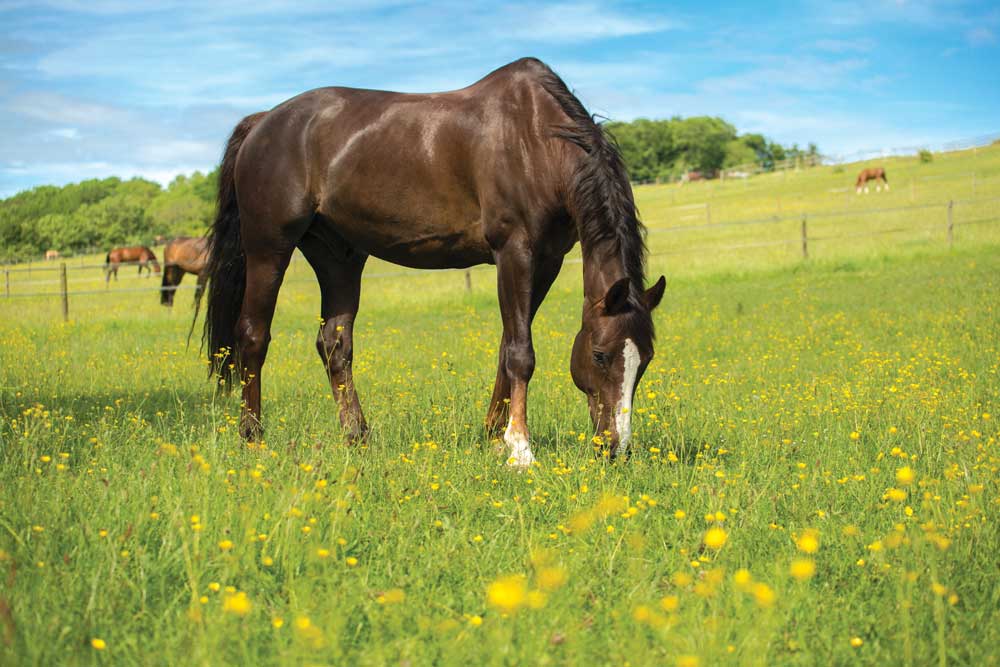An integrative approach to the detection and management of snakebites.
While curiosity is often a good feature in horses, it can sometimes come back to bite them! Snakebites usually occur on a horse’s nose when he puts his head down to smell the snake to see what it is. Snake bites can range from mild to life-threatening, so if you suspect that your horse has been bitten, always call your veterinarian. I have seen horses that needed a tracheotomy, and others who suffered from pharyngeal paralysis, following a snakebite. Immediate action and quick thinking can help save your horse’s life.
Keep his airway open
The first thing you need to do after a snakebite is make sure your horse has an open airway. Hair rollers or pieces of garden hose (or anything that is round and will stay open) can be pushed into the nostrils to keep the nose from swelling shut. If the nose does swell shut, a tracheotomy can be performed to open an airway lower in the respiratory system. This is best performed by a veterinarian. In a pinch, you can try cutting horizontally between the tracheal rings to save the horse’s life.
Treat the pain and swelling
Once you have made sure there is a patent airway, you can treat for pain and swelling.
- Arnica Montana is always a good homeopathic remedy to use for pain.
- I keep the homeopathic nosode Crotalus Horridus on hand as well; it is made from the venom of a rattlesnake. Homeopathic nosodes are made by diluting the snake venom until just the energetic footprint is left (less than Avogadro’s number, which means no phorses of the original substance are left).
Other homeopathic remedies used for snakebites include:
- Lachesis for bites where the skin around the bite is discolored with a bluish or purple hue
- Echinacea for infection
- Ledum to treat the puncture and prevent tetanus
- Vipera for bites from viper-type snakes. Viper snakes usually cause a huge amount of swelling and phlebitis.
Less often, you may try:
- Cedron for malarial type symptoms following the bite
- Golondrina if a blood toxin has been injected into the animal by the snake
- Guaco for nerve toxins
- Naja for cobra venom.
Beware of using isopathic (identical) venom in very severe cases during the acute phase. It is better to choose a homeopathic remedy that mimics the symptoms your horse is showing rather than use the nosode made from the venom of the snake that bit your horse.
You can wash the affected area out with a combination of Calendula and Hypericum solution. Be sure the solutions do not contain alcohol, which will burn. Calendula is soothing and will help stop bleeding, and Hypericum is good for injured nerves. Rescue Remedy can also be used for a rinse, as can Traumeel, a product made by the Heel Corporation. You can give the Rescue Remedy or Traumeel orally as well. Aloe Vera is also helpful, topically or internally.
In terms of conventional care, I like to spray DMSO on the area that was bitten, using a spray bottle, as the horse usually resents any touching of the affected area. The DMSO will reduce the swelling. I also give the horse Banamine for pain, swelling and shock. I will use Dexamethasone if the horse is not prone to laminitis, as it will also decrease the swelling and damage to the tissue.
Get creative
You may need to use some creative thinking to keep your horse comfortable, depending on his symptoms and their severity. I once had a couple of horses get into a den of baby rattlesnakes. It was the worst case I had ever seen. They had multiple bites on their noses, and were developing lymphangitis and tremendous edema and swelling of their faces. They felt really poorly, were terribly painful, and insisted on hanging their heads very low, which encouraged more edema to develop. I padded some 55-gallon drums and tied them where the horses could rest their heads on the tops of the drums. This provided them with some relief and helped reduce the swelling.
As you can see, snakebites are not something to play around with. While some can be mild, many can also be severe. You should always call your veterinarian if you suspect your horse has been on the receiving end of a snake’s strike.








